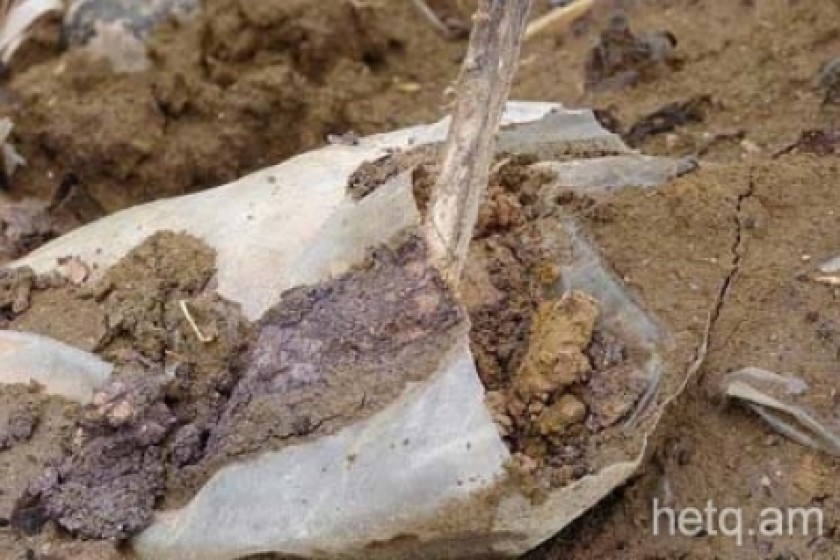
"There are emissions from the toxic-waste dump," insists ecologist Lilik Simonyan
"Before a final solution is found, it is necessary to fence in the dump, to dig gutters and to study the body of the landslide. In order to carry all this out, we will need 10 million drams (about $18,000)," says Ludwig Nazaryan, the head of the Division of Technological Disasters of the Department for Emergency Situations (DES). As we have already reported, a toxic-waste dump containing 500 metric tons of insecticide, located east of the Vardashen-Verin Jrashen neighborhood in the district of Erebuni, is situated in an area of active landslide. According to ecologists and scientists, it may collapse at any moment, causing an ecological disaster.
After receiving a letter from the Association of Investigative Journalists that warned that the neglected state of the dump posed a threat to the environment, the Department for Emergency Situations (DES) informed Prime Minister Andranik Margaryan of the problem. As a result, representatives of the Ministry of Ecology, the Ministry of Agriculture, the DES and the Yerevan Mayor's Office met to discuss the issue of how to deal with the situation in the dump. "We presented the government with our proposals. It's now up to them which proposal to accept and how to finance its implementation. After that the government will decide which agency and experts will be dealing with the matter," says Igor Sargisyan, the deputy head of the State Ecological Inspection. According to the prime minister's instructions, representatives of the NGO Armenian Women for Health and a Healthy Environment were to take part in the deliberations. But Lilik (Lia) Simonyan from this NGO was invited as a guest and was not given the opportunity to participate in the discussion. Her organization has been concerned with the problems related to the dump for several years. "We have a study showing that there are emissions from the toxic-waste dump. In other words, the site poses a threat to people's health. We must find an ecologically correct solution. Taking into consideration our country's means, we think that it is imperative that the international organizations intervene," Simonyan says.
In 2001 the Republic of Armenia signed the Stockholm Convention on Persistent Organic Pollutants, a global treaty to "protect human health and the environment from persistent organic pollutants (POPs)". According to Article 6 of the Convention, the state-parties should take measures to identify stockpiles consisting of or containing chemicals listed in the annexes to the Convention, manage the stockpiles in a safe, efficient and environmentally sound manner, and eliminate or reduce the release of POPs into the environment. In implementing the Convention, governments of the developed countries agreed to provide timely and appropriate technical assistance and to promote the transfer of technology, as well as to provide, within their capabilities, financial support and incentives to developing countries and to countries with economies in transition.
Anahit Alexanyan, the head of the Department on Management of Wastes and Toxic Agents of the Ministry of Ecology is responsible for the fulfillment of the Convention's requirements. In a telephone interview she told us that a national program is being drafted by the ministry and that they are working on identifying all stockpiles in Armenia consisting of or containing the chemicals in question. We were unable to find out whether the toxic-waste dump in Erebuni, containing 500 metric tons of insecticide, has been identified within the framework of the Convention. Anahit Alexanian couldn't find the time to answer all our questions, saying that she was busy with other, more important and more pressing issues. It is worth mentioning that the government of Armenia has received a $500,000 grant for drafting this national program. Anahit Alexanyan herself is managing the grant.
Although the DES has not studied the landslide and the state of the dump yet, Ludwig Nazaryan insists, "Nothing has happened for 20-25 years, so nothing will happen for another 20-25 year period. The landslide is far from the toxic-waste dump and will not reach the site." But the only person who has studied the site where 500 metric tons of insecticide are buried, the head of the geo-ecological laboratory of the Institute of Geology of the National Academy of Science, R. Yadoyan, insists that the dump is situated in an area of landslide and in the case of the slightest disturbance of the balance it will become active.
 Videos
Videos Photos
Photos




Write a comment